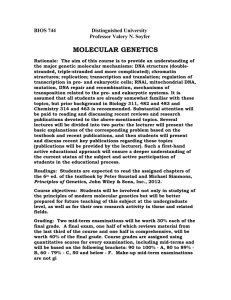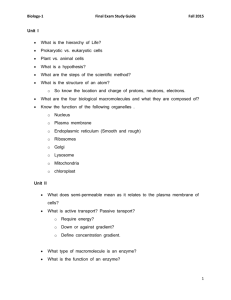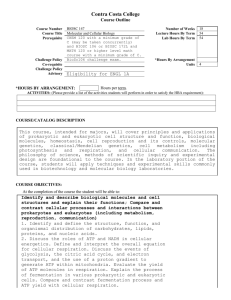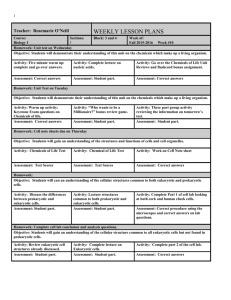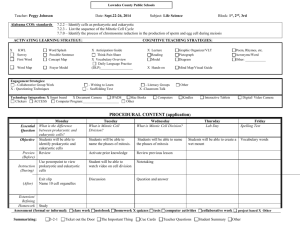BIOSC 147-S14 - Contra Costa College
advertisement
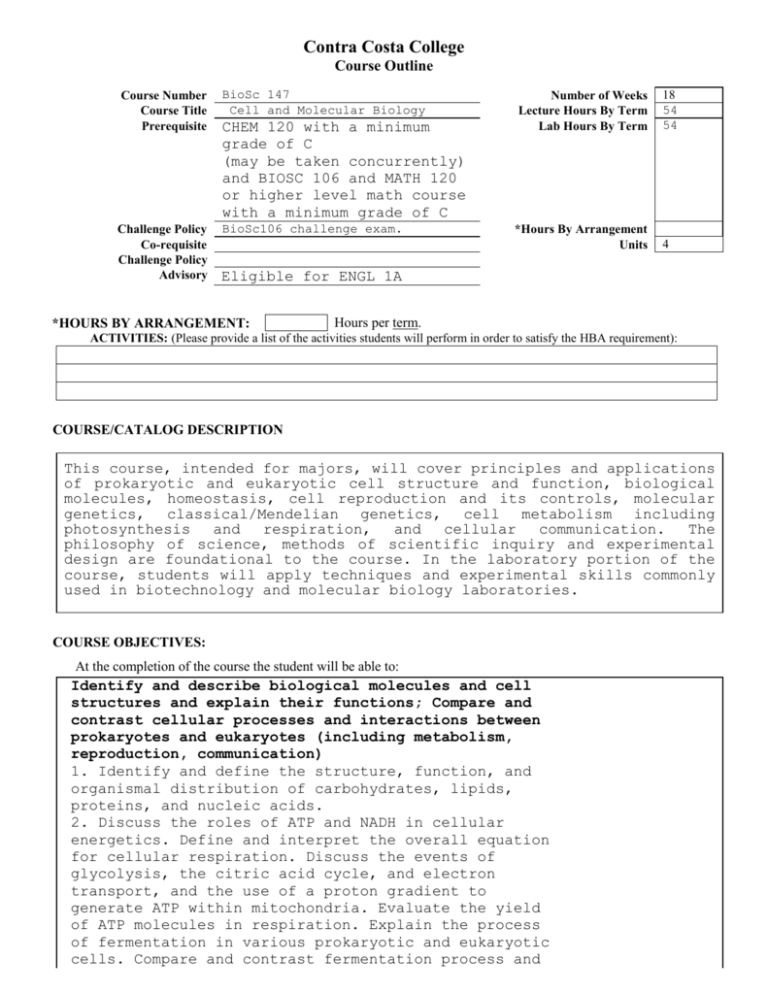
Contra Costa College Course Outline Course Number Course Title Prerequisite BioSc 147 Cell and Molecular Biology Challenge Policy Co-requisite Challenge Policy Advisory BioSc106 challenge exam. CHEM 120 with a minimum grade of C (may be taken concurrently) and BIOSC 106 and MATH 120 or higher level math course with a minimum grade of C Number of Weeks Lecture Hours By Term Lab Hours By Term *Hours By Arrangement Units 18 54 54 4 Eligible for ENGL 1A *HOURS BY ARRANGEMENT: Hours per term. ACTIVITIES: (Please provide a list of the activities students will perform in order to satisfy the HBA requirement): COURSE/CATALOG DESCRIPTION This course, intended for majors, will cover principles and applications of prokaryotic and eukaryotic cell structure and function, biological molecules, homeostasis, cell reproduction and its controls, molecular genetics, classical/Mendelian genetics, cell metabolism including photosynthesis and respiration, and cellular communication. The philosophy of science, methods of scientific inquiry and experimental design are foundational to the course. In the laboratory portion of the course, students will apply techniques and experimental skills commonly used in biotechnology and molecular biology laboratories. COURSE OBJECTIVES: At the completion of the course the student will be able to: Identify and describe biological molecules and cell structures and explain their functions; Compare and contrast cellular processes and interactions between prokaryotes and eukaryotes (including metabolism, reproduction, communication) 1. Identify and define the structure, function, and organismal distribution of carbohydrates, lipids, proteins, and nucleic acids. 2. Discuss the roles of ATP and NADH in cellular energetics. Define and interpret the overall equation for cellular respiration. Discuss the events of glycolysis, the citric acid cycle, and electron transport, and the use of a proton gradient to generate ATP within mitochondria. Evaluate the yield of ATP molecules in respiration. Explain the process of fermentation in various prokaryotic and eukaryotic cells. Compare and contrast fermentation process and ATP yield with cellular respiration. 3. Define and interpret the overall equation for photosynthesis. Discuss, compare, and contrast the molecular events of the light and dark reactions. Discuss the functional anatomy of leaves and chloroplasts and their involvement in photosynthesis. 4. Identify, explain, and interpret the distribution, structure, and function of organelles in eukaryotic cells. Compare and contrast the structure and functions of prokaryotic and eukaryotic cells. Discuss the origin of prokaryotic and eukaryotic cells. Define and give examples of tissues, organs, and organ systems in animals and plants. 5. Explain, discuss, and interpret cell-signaling systems. Explain, discuss and interpret the structure and functions of various hormones and endocrine glands in invertebrates and vertebrates. Explain how these process are involved in organismal homeostasis. 6. Define, interpret, and provide examples of the various kinds of passive and active transport occurs in cells. 7. List, evaluate, and discuss the biochemistry and mode of operation of hormones and other regulatory substances, and environmental factors influencing the growth of plants 8. Describe and discuss those factors determining and affecting the growth rate of populations. Apply the principles of classical and molecular genetics to solve problems in genetics and biotechnology; Explain how DNA replicates and transmits genetic information within organisms. 1. Define, explain, and interpret the basic vocabulary of genetics. Analyze and solve basics problems in Mendelian genetics. Analyze and solve problems involving non-Mendelian genetics. Define and explain mutations, and their molecular and cellular consequences 2. Explain recent advances in genetic engineering and biotechnology involving the introduction of new or modified genetic material into the organismal genome and the cloning of organisms. 3. Analyze proteins using chromatography, SDS-PAGE, and ELISA technologies. Determine protein concentration with a microtiter plate format assay. 4. Analyze DNA molecules using the polymerase chain reaction and agarose gel electrophoresis, determine the relative sizes of DNA molecules using standards. 5. Discuss the process of cellular reproduction in prokaryotic and eukaryotic cells. 6. Identify, explain, and interpret the events and sub-divisions of mitosis and cytokinesis in both animal and plant cells. Compare and contrast mitosis with meiosis; identify, explain, and interpret the events and sub-divisions of meiosis. 7. Explain, interpret, and discuss the structure and function of DNA. Discuss the process of DNA replication. Explain, interpret, and discuss the encoding of genetic information in DNA, and how this is later expressed in transcription and translation. Construct the flow diagram of gene expression from DNA to protein 8. Compare and contrast DNA replication and gene expression in prokaryotic and eukaryotic cells. Evaluate the timing of these events in the cell cycle. Explain and interpret those factors regulating the expression of genes in prokaryotic and eukaryotic cells. 9. Discuss the general structure and function of viruses. Compare and contrast the lytic and lysogenic cycles of viruses. Relate evolutionary processes to the origin and evolution of cells. 1. Define, explain, and interpret evolution and natural selection. Explain how our understanding of natural selection and evolution is applied in Biotechnology and Molecular Biology Apply the processes of scientific inquiry and experimental design to the study of biological concepts; Acquire, read, evaluate, apply and cite scientific literature; Practice scientific writing 1. Use laboratory investigations and appropriate procedures to generate accurate and meaningful data and derive reasonable conclusions from them 2. Understand, analyze and interpret scientific articles. Connect ideas discovered in scientific articles to a broader context, including other scientists’ ideas 3. Present laboratory findings using the format of scientific writing. Include a clear thesis synthesizing ideas from both new data and a variety of sources Organize ideas logically and effectively according to the standard scientific paper format. Properly cite papers used in background and analysis sections. INTENDED STUDENT LEARNING OUTCOMES: CSLO 1: Outcome: Demonstrate knowledge of the structure and function of the 4 groups of organic molecules occurring in living organisms (PSLO 9) Assessment Criteria: Each question will be answered correctly by 75 % of the students Assessment: To demonstrate CSLO 1, the student will answer embedded questions in course examinations CSLO 2: Outcome: Demonstrate knowledge of the structure and function of organelles occurring in cells Assessment Criteria: Each question will be answered correctly by 75 % of the students Assessment: To demonstrate CSLO 2, the student will answer embedded questions in course examinations CSLO 3: Outcome: Demonstrate knowledge of differences between anabolic and catabolic energy metabolism in cells Assessment Criteria: Each question will be answered correctly by 75 % of the students Assessment: To demonstrate CSLO 3, the student will answer embedded questions in course examinations CSLO 4: Outcome: Demonstrate knowledge of the inheritance and expression of alleles in different patterns of inheritance Assessment Criteria: Each question will be answered correctly by 75 % of students Assessment: To demonstrate CSLO 4, the student will answer embedded questions in course examinations CSLO 5: Outcome: Demonstrate knowledge of the structure of DNA and its expression in protein synthesis Assessment Criteria: Each question will be answered correctly by 75 % of the students Assessment: To demonstrate CSLO 5, the student will answer embedded questions in course examinations CSLO 6: Outcome: accurately set up reaction mixes Assessment Criteria: 75% of the PCR reaction setup practices evaluated will show proficiency. Success of procedure will be evaluated based on how many lanes of an agarose gel show a band (picture of gel is documentation). Student calculations will be evaluated according to rubric Assessment: To demonstrate CSLO 6, the student will perform calculations, set up reactions, and run samples on an agarose gel to show proficiency in performance of the Polymerase Chain Reaction CSLO 7: Outcome: correctly perform calculations for and prepare buffers Assessment Criteria: 75% of students in a course will show proficiency (correct calculations according to a rubric and pH of student buffers within an acceptable range checked with pH paper or a pH meter) for the buffer preparation practices evaluated. Assessment: To demonstrate CSLO 7, the student will perform calculations on a worksheet and prepare buffers in the lab. COURSE CONTENT (Lecture): 1. Structure and Function of Prokaryotic and Eukaryotic Cells a. Cell theory: Distribution, structure, and functions of Eukaryotic and Prokaryotic cells. 2. Origin and evolution of cellular life and molecular evolution a. Evolution of cells, organelles, tissues, organs, and the molecules involved b. Applications of knowledge of natural selection and evolution in Biotechnology and Molecular Biology c. Viral structure and function 3. Organelle structure and function a. Organelles, molecules, and cellular function 4. Membrane structure and function a. Fluid mosaic model, trans-membrane proteins b. Cell signaling 5. Cellular transport a. Endocytosis, exocytosis b. Endomembrane and cytoskeletal system 6. Cellular chemistry and biomolecules a. pH scale, acids and bases. b. Structures, formulae and functions of simple compounds and basic biological molecules (carbohydrates, lipids, proteins, and nucleic acids). c. Structure and function of organic molecules 7. Cellular metabolism (respiration and photosynthesis) a. Cellular respiration and fermentation b. Photosynthesis 8. Cell reproduction and its controls a. Cellular reproduction: prokaryotic and eukaryotic b. Cell cycle c. Growth regulation d. Control of prokaryotic reproduction and sporulation 9. Cell communication a. Cell signaling b. Immune system 10.Classical/Mendelian genetics a. Mendelian and non-Mendelian genetics b. Meiosis and life cycles 11.Molecular genetics a. Relationship of DNA sequence and gene expression to genotypes and phenotypes b. Analysis of alleles using DNA sequence technologies c. Molecular phenotypes 12.DNA structure and function a. DNA structure and replication b. Gene regulation 13.Gene structure, gene expression and control of gene expression a. Transcription and translation b. Promoter, coding sequence, un-translated regions c. Molecules and logic of regulation of gene expression 14.Biotechnology a. DNA technology and its applications b. Biotechnology and Molecular Biology concepts: i. Recombinant protein production ii. UV spectrophotometry iii. Column chromatography iv. Microtiter plate format protein assay v. SDS-PAGE vi. Critical examination and analysis of data vii. Genomic DNA extraction viii. Polymerase chain reaction (PCR) ix. Agarose gel electrophoresis 15.Scientific Inquiry a. Use of the scientific method to test and modify ideas about our understanding of molecular biology concepts COURSE CONTENT (Lab): 1. Microscopy -preparation and analysis of samples using of dissecting, compound, and fluorescence microscopes. a. Microscopes: Testing predictions that compare prokaryotic and eukaryotic cells b. Microscopes: Testing predictions about similarities and differences between plant, animal, protist, and fungal cells (and tissues) c. Microscopes: Using fluorescence microscopy to analyze the relationship between protein expression, localization, and cell function 2. Testing hypothesis about effects of genetics and environment on metabolic pathways a. Measurement and analysis of cellular respiration and fermentation under varying environmental and genetic conditions b. Measurement and analysis of Photosynthesis under varying environmental and genetic conditions 3. Techniques and data analysis related to protein structure and function a. Using enzyme activity assays to test predictions about enzyme function under various conditions b. Use of cell culture, protein purification and SDS-PAGE to investigate protein expression, structure, and function c. Quantitation of protein using spectrophotometry and standard curves 4. Testing hypothesis about relationships between genotypes, gene expression, and measurable pheontypes using classiscal and molecular genetic techinques a. Genetic analysis of meiosis and fertilization using punnett squares and observable data b. Molecular and genetic analysis of eukaryotes using PCR genotyping and phenotypes c. Molecular and genetic analysis of prokaryotes using restriction digests, DNA electrophoresis, selective and differential media d. Analysis of natural selection and evolution using comparative sequence analysis 5. Use of and analysis of data from other common techniques used in the field of cellular and molecular biology a. Use of antibody assay technologies (Western blot or ELISA) to detect and analyze the presence of molecules in samples b. Control and analysis of population growth using cell culture techniques METHODS OF INSTRUCTION: Lecture Lab Collaborative Learning/Peer Review Computer Assisted Instruction Demonstration/Modeling Discussion Field trips Supervised practice with instrumentation used in assays of biological macromolecules and cell biology INSTRUCTIONAL MATERIALS: NOTE: To be UC/CSU transferable, the text must be dated within the last 7 years OR a statement of justification for a text beyond the last 7 years must be included. Textbook Title: Life: The Science of Biology Author: David E. Sadava, H. Craig Heller, David M. Hillis, May Berenbaum. Publisher: Sinauer/Freeman Publishing Edition/Date: 10th ed Textbook Reading Level: Justification Statement: (For textbook beyond 7 years) Lab Manual Title Laboratory Manual for BioSc 147: Cell and Molecular Biology Author: Krolikowski, K. and Tarp, C. Publisher: Contra Costa College Bookstore Edition/Date: 12-15-2014 OUTSIDE OF CLASS WEEKLY ASSIGNMENTS: Title 5, section 55002.5 establishes that a range of 48 -54hours of lecture, study, or lab work is required for one unit of credit. For each hour of lecture, students should be required to spend an additional two hours of study outside of class to earn one unit of credit. State mandates that sample assignments must be included on the Course Outline of Record. Outside of Class Weekly Assignments Hours per week Weekly Reading Assignments (Include detailed assignment below, if applicable) 3 See attached file, BioSc147_sample_assignments Weekly Writing Assignments (Include detailed assignment below, if applicable) 1 See attached file, BioSc147_sample_assignments Weekly Math Problems (Include detailed assignment below, if applicable) Lab or Software Application Assignments (Include detailed assignment below, if applicable) 2 Other Performance Assignments (Include detailed assignment below, if applicable) Lecture, Team-based projects and discussions, Homework problems, Reports and presentations, Laboratory experiments, Laboratory reports, Laboratory practical exams STUDENT EVALUATION: (Show percentage breakdown for evaluation instruments) Course must require use of critical thinking, college-level concepts & college-level learning skills. For degree credit, course requires essay writing unless that requirement would be inappropriate to the course objectives. If writing is inappropriate, there must be a requirement of problem-solving or skills demonstration. 42 % Essay (If essay is not included in assessment, explain below.) 12 % % Computation or Non-computational Problem Solving Skills Skills Demonstration 10 36 % Objective Examinations Other (describe) % Laboratory assignments: Weekly Quizzes, Written work in the form of laboratory reports (drawings, answers to questions, analysis of experimental results) for all labs % % GRADING POLICY: (Choose LG, P/NP, or SC) X Letter Grade Pass / No Pass 90% - 100% = A 80% - 89% = B 70% - 79% = C 60% - 69% = D Below 60% = F Prepared by: Date: Revised form 01/14 70% and above = Pass Below 70% = No Pass Student Choice 90% - 100% = A 80% - 89% = B 70% - 79% = C 60% - 69% = D Below 60% = F or 70% and above = Pass Below 70% = No Pass
